All You Need To Know About
The Golden Circle In Iceland
By Michael Chapman
Iceland’s most popular sightseeing trail is known as “Gullni hringurinn” in Icelandic, and the Golden Circle to the rest of us. There are three major highlights en route; Þingvellir National Park, the Geysir hot springs and Gullfoss waterfall, all of which attract thousands of visitors each year with their dramatic scenery and importance to local culture.
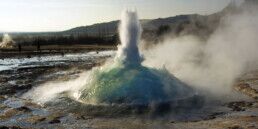
Thanks to its proximity to Iceland’s capital city, Reykjavík, undertaking the Golden Circle is the perfect activity for those looking to maximise their stay and is especially practical for travellers with only a limited time in the country.
Whoever you are, this unforgettable journey has a little something for you. Be you part of a family hungry for adventure, a honeymooner hunting for romance, or a photographer seeking out your next award-winning shot; the Golden Circle is sure to provide you with what you’re looking for, and so much more.
Iceland’s most popular sightseeing trail is known as “Gullni hringurinn” in Icelandic, and the Golden Circle to the rest of us. There are three major highlights en route; Þingvellir National Park, the Geysir hot springs and Gullfoss waterfall, all of which attract thousands of visitors each year with their dramatic scenery and importance to local culture.

Thanks to its proximity to Iceland’s capital city, Reykjavík, undertaking the Golden Circle is the perfect activity for those looking to maximise their stay and is especially practical for travellers with only a limited time in the country.
Whoever you are, this unforgettable journey has a little something for you. Be you part of a family hungry for adventure, a honeymooner hunting for romance, or a photographer seeking out your next award-winning shot; the Golden Circle is sure to provide you with what you’re looking for, and so much more.
Where is the Golden Circle in Iceland?
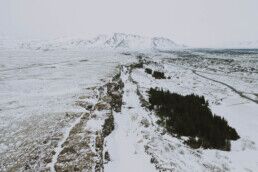
The Golden Circle route is located in the Bláskógabyggð municipality of southwest Iceland and covers a total distance of 300 kilometres.
Visitors can reach Þingvellir—considered the first stop by most—after a short forty-minute drive from Reykjavík, covering a distance of some 48 kilometres. Nothing can quite describe that feeling as you leave the concrete confines of the city behind, embarking inland into a landscape of vast black fields and distant mountainscapes.
From Þingvellir, you will swing into the higher regions of the southwest, passing a diverse landscape that can swiftly transform from mossy lava fields to quaint meadows and farmland. Geysir geothermal valley is found among the latter category, marking a drastic change in aesthetic from the park.
As you traverse the higher plateaus of your trip, you will look upon Gullfoss water cascading into a dramatic canyon, before returning towards Reykjavík on the southwestern coast.The waterfall marks the most inland point of the Golden Circle, and is 115.8 kilometers from the capital, approximately a 1 hour and 40 minute drive.
Where is the Golden Circle in Iceland?

The Golden Circle route is located in the Bláskógabyggð municipality of southwest Iceland and covers a total distance of 300 kilometres.
Visitors can reach Þingvellir—considered the first stop by most—after a short forty-minute drive from Reykjavík, covering a distance of some 48 kilometres. Nothing can quite describe that feeling as you leave the concrete confines of the city behind, embarking inland into a landscape of vast black fields and distant mountainscapes.
From Þingvellir, you will swing into the higher regions of the southwest, passing a diverse landscape that can swiftly transform from mossy lava fields to quaint meadows and farmland. Geysir geothermal valley is found among the latter category, marking a drastic change in aesthetic from the park.
As you traverse the higher plateaus of your trip, you will look upon Gullfoss water cascading into a dramatic canyon, before returning towards Reykjavík on the southwestern coast.The waterfall marks the most inland point of the Golden Circle, and is 115.8 kilometers from the capital, approximately a 1 hour and 40 minute drive.
How long does the Golden Circle take?
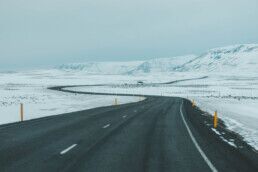
How long it will take you to visit each of the three sites of the Golden Circle will depend on various factors, from the season of your visit to the weather conditions that day.
Those who undergo the experience during winter will have to drive slower on the roads and will likely encounter adverse weather conditions at some point during their travels. On the other hand, summer visitors will have more daylight hours to work with, allowing for exciting late-night visits and a more relaxed schedule.
Tour providers and travel agencies will usually allot eight hours for the Golden Circle, considering how long it takes to drive between each attraction and the time spent appreciating them.
Those who drive themselves are afforded more flexibility in how they wish to experience the trail, free to make stops and diversions as they so desire. Travellers desperate to maximise each moment of their time on the Golden Circle should consider splitting the trip over a few days.
How long does the Golden Circle take?

How long it will take you to visit each of the three sites of the Golden Circle will depend on various factors, from the season of your visit to the weather conditions that day.
Those who undergo the experience during winter will have to drive slower on the roads and will likely encounter adverse weather conditions at some point during their travels. On the other hand, summer visitors will have more daylight hours to work with, allowing for exciting late-night visits and a more relaxed schedule.
Tour providers and travel agencies will usually allot eight hours for the Golden Circle, considering how long it takes to drive between each attraction and the time spent appreciating them.
Those who drive themselves are afforded more flexibility in how they wish to experience the trail, free to make stops and diversions as they so desire. Travellers desperate to maximise each moment of their time on the Golden Circle should consider splitting the trip over a few days.
The Top Attractions on the Golden Circle in Iceland
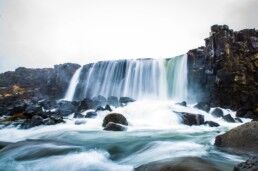
Þingvellir National Park, Geysir geothermal springs and Gullfoss waterfall are considered the holy trinity of attractions in southwest Iceland. How you choose to explore these sites is entirely up to you, though might we recommend our own Golden Circle bubble tour.
Not only will our experienced, friendly and professional guides show you around each location, but you’ll also spend the night in one of our great transparent bubbles. Only a short distance from all the main attractions, this novel choice of accommodation allows for utter immersion in the Icelandic wilderness.
The Golden Circle route has much to offer guests besides the three superstar attractions that have made it famous worldwide. Volcanic craters, luxury spas and fine-dining are all options when it comes to taking a diversion. Still, first things first, we must concentrate on the most beloved sites, starting with the infinitely fascinating national park, Þingvellir.
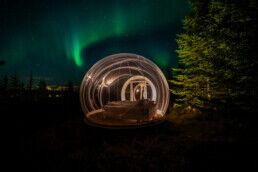
The Top Attractions on the Golden Circle in Iceland

Þingvellir National Park, Geysir geothermal springs and Gullfoss waterfall are considered the holy trinity of attractions in southwest Iceland. How you choose to explore these sites is entirely up to you, though might we recommend our own Golden Circle bubble tour.
Not only will our experienced, friendly and professional guides show you around each location, but you’ll also spend the night in one of our great transparent bubbles. Only a short distance from all the main attractions, this novel choice of accommodation allows for utter immersion in the Icelandic wilderness.
The Golden Circle route has much to offer guests besides the three superstar attractions that have made it famous worldwide. Volcanic craters, luxury spas and fine-dining are all options when it comes to taking a diversion. Still, first things first, we must concentrate on the most beloved sites, starting with the infinitely fascinating national park, Þingvellir.

Thingvellir National Park
Designated as a UNESCO World Heritage site since 2004, Þingvellir National Park is widely recognised for its beautiful environment, unique geology and essential role in Icelandic history.
After arriving at the modern Visitor’s Centre, most travellers begin their time here at the viewpoint, which provides staggering scope over the park. To the southeast, visitors will have a fantastic vantage over the glittering waters of Þingvallavatn—the largest natural lake in Iceland—as well as the iconic Þingvallakirkja church and several mountains and volcanoes.
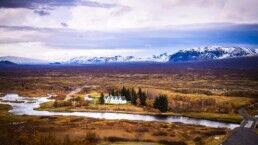
Given the viewpoint is situated atop the Almannagjá gorge, guests will find themselves standing on the edge of the North American tectonic plate, which stands exposed from the earth alongside the Eurasian plate, visible across the lava fields of the Mid-Atlantic Ridge.
The Mid-Atlantic ridge is colloquially referred to as a ‘Continental No-Man’s Land’. Indeed, the North American and Eurasian plates are drifting apart at a rate of 1 millimetre each year, securing this beautiful location as one of the most exciting examples of living geology on the planet.
A pathway leads from the viewpoint down alongside the North American plate, with display and information boards placed at the relevant points. These are more than worth stopping for as they provide a fantastic insight into the life-changing events in the area over the last 1000 years.
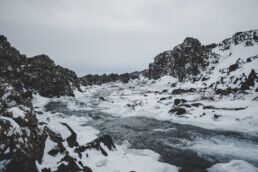
Among its most astounding claims to fame, Þingvellir was where the world’s oldest democratically elected parliament, the Alþingi, was formed around the year 930 AD. Large outdoor assemblies (known as things) would congregate here throughout the ages to enact new legislation, settle tribal disputes and punish criminals. It is for this reason that Þingvellir is translated to ‘Fields of Parliament‘.
One of the most critical decisions made here was to convert the Icelandic people en masse from Norse paganism to Christianity. This historically important event occurred in 1000 AD due to external pressure from outside nations unwilling to trade with heathens.
In Iceland, this incident is referred to as kristnitaka (“the taking of Christianity”). According to the ancient sagas, the Law Speaker, Þorgeir Þorkelsson, took three days and nights to decide Iceland’s religious future. Interestingly enough, Icelandic pagans were still permitted to worship the Norse pantheon of gods, the Æsir, as long as they did so in secret.
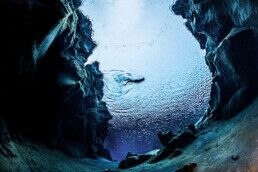
Back to our present day, one of the most appealing activities guests can partake in during the Golden Circle in Iceland is taking a dip in the crystalline glacial spring, Silfra Fissure. While at first, you might think it a daunting task, thermal drysuits, gloves and hoods ensure that anyone who takes to the water is well equipped to deal with the cold temperature.
Floating through this vast underwater canyon, you’ll be astonished by the beauty on offer. The water’s purity promises visibility of up to 100 metres, allowing you clear views over the site’s dark cliff sides and bright green algae. However, do note that you must be a competent swimmer to book a snorkelling tour, while diving tours require evidence of drysuit certification and logged coldwater dives.
If you decide you want to discover Silfra Fissure for yourself, we advise you to take the morning tour, rather than the afternoon. This way, we can pick you up from Þingvellir when your time in the water’s done, allowing you ample time to enjoy the rest of our unforgettable Golden Circle Bubble tour.
Available in both summer and the winter, you can check out more details on this package on our Guided Tours and Accommodation page.
Thingvellir National Park
Designated as a UNESCO World Heritage site since 2004, Þingvellir National Park is widely recognised for its beautiful environment, unique geology and essential role in Icelandic history.
After arriving at the modern Visitor’s Centre, most travellers begin their time here at the viewpoint, which provides staggering scope over the park. To the southeast, visitors will have a fantastic vantage over the glittering waters of Þingvallavatn—the largest natural lake in Iceland—as well as the iconic Þingvallakirkja church and several mountains and volcanoes.

Given the viewpoint is situated atop the Almannagjá gorge, guests will find themselves standing on the edge of the North American tectonic plate, which stands exposed from the earth alongside the Eurasian plate, visible across the lava fields of the Mid-Atlantic Ridge.
The Mid-Atlantic ridge is colloquially referred to as a ‘Continental No-Man’s Land’. Indeed, the North American and Eurasian plates are drifting apart at a rate of 1 millimetre each year, securing this beautiful location as one of the most exciting examples of living geology on the planet.
A pathway leads from the viewpoint down alongside the North American plate, with display and information boards placed at the relevant points. These are more than worth stopping for as they provide a fantastic insight into the life-changing events in the area over the last 1000 years.

Among its most astounding claims to fame, Þingvellir was where the world’s oldest democratically elected parliament, the Alþingi, was formed around the year 930 AD. Large outdoor assemblies (known as things) would congregate here throughout the ages to enact new legislation, settle tribal disputes and punish criminals. It is for this reason that Þingvellir is translated to ‘Fields of Parliament‘.
One of the most critical decisions made here was to convert the Icelandic people en masse from Norse paganism to Christianity. This historically important event occurred in 1000 AD due to external pressure from outside nations unwilling to trade with heathens.
In Iceland, this incident is referred to as kristnitaka (“the taking of Christianity”). According to the ancient sagas, the Law Speaker, Þorgeir Þorkelsson, took three days and nights to decide Iceland’s religious future. Interestingly enough, Icelandic pagans were still permitted to worship the Norse pantheon of gods, the Æsir, as long as they did so in secret.

Back to our present day, one of the most appealing activities guests can partake in during the Golden Circle in Iceland is taking a dip in the crystalline glacial spring, Silfra Fissure. While at first, you might think it a daunting task, thermal drysuits, gloves and hoods ensure that anyone who takes to the water is well equipped to deal with the cold temperature.
Floating through this vast underwater canyon, you’ll be astonished by the beauty on offer. The water’s purity promises visibility of up to 100 metres, allowing you clear views over the site’s dark cliff sides and bright green algae. However, do note that you must be a competent swimmer to book a snorkelling tour, while diving tours require evidence of drysuit certification and logged coldwater dives.
If you decide you want to discover Silfra Fissure for yourself, we advise you to take the morning tour, rather than the afternoon. This way, we can pick you up from Þingvellir when your time in the water’s done, allowing you ample time to enjoy the rest of our unforgettable Golden Circle Bubble tour.
Available in both summer and the winter, you can check out more details on this package on our Guided Tours and Accommodation page.
Geysir Geothermal Area
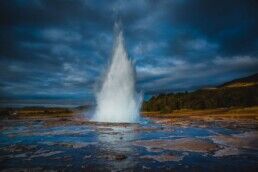
This phenomenal site is known as Haukadalur, though it is more commonly referred to by travel guides and locals as Geysir geothermal area. Either way, this area is one of the staples of the Golden Circle in Iceland, and is considered a favourite stop by many.
With its bubbling mud cauldrons and steaming fumaroles, this site is where the hot spring, Geysir, is found. Geysir is best known for lending its name to similar sites across the globe.
While Geysir is no longer active, its neighbour Strokkur has stolen the limelight over recent years with its high-octane, high-profile eruptions. With a name that translates to “churn,” it is perhaps no surprise that Strokkur routinely shoots boiling water to heights exceeding twenty metres, creating a true spectacle of nature.
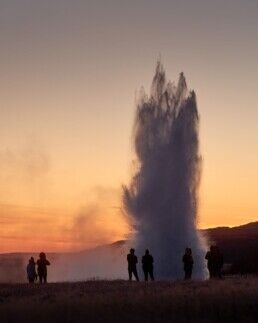
The hot spring jettisons water every five to ten minutes, so make sure to stick around on-site if you have yet to witness this incredible phenomenon in action. In the meantime, explore the many other small hot pockets and geothermal formations on-site. Make sure to keep a safe distance; however; the water is exceedingly hot and more than capable of causing injury.
Across the road from the geothermal site is the Geysir Centre, making for the perfect stop for a little respite and a bite-to-eat.
After you’ve finished tucking into the delicious food, dished up in a steaming buffet, feel free to wander back to the geothermal area in order to catch another glimpse of Strokkur in action before you go.
Geysir Geothermal Area

This phenomenal site is known as Haukadalur, though it is more commonly referred to by travel guides and locals as Geysir geothermal area. Either way, this area is one of the staples of the Golden Circle in Iceland, and is considered a favourite stop by many.
With its bubbling mud cauldrons and steaming fumaroles, this site is where the hot spring, Geysir, is found. Geysir is best known for lending its name to similar sites across the globe.
While Geysir is no longer active, its neighbour Strokkur has stolen the limelight over recent years with its high-octane, high-profile eruptions. With a name that translates to “churn,” it is perhaps no surprise that Strokkur routinely shoots boiling water to heights exceeding twenty metres, creating a true spectacle of nature.

The hot spring jettisons water every five to ten minutes, so make sure to stick around on-site if you have yet to witness this incredible phenomenon in action. In the meantime, explore the many other small hot pockets and geothermal formations on-site. Make sure to keep a safe distance; however; the water is exceedingly hot and more than capable of causing injury.
Across the road from the geothermal site is the Geysir Centre, making for the perfect stop for a little respite and a bite-to-eat.
After you’ve finished tucking into the delicious food, dished up in a steaming buffet, feel free to wander back to the geothermal area in order to catch another glimpse of Strokkur in action before you go.
Gullfoss Waterfall
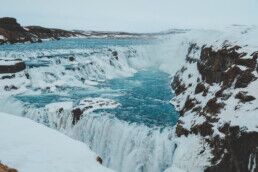
Gullfoss (“Golden Falls”) is a dramatic two-tier waterfall on the Hvítá river, located amidst the otherwise quaint agricultural surroundings of southwest Iceland. On approach, guests will likely spot an enormous plume of steam rising over the surrounding hilltops. So too will they hear the thunderous roar of rushing water. Then it appears, a true titan of the landscape.
Falling a total of 32 metres, Gullfoss cascades over two rocky steps, its frothing waters feeding the hungry mouth of Gullfossgjúfur canyon below. On either side of the river, the cliff sides rise to seventy metres, perfectly framing the waterfall for photographers looking upon it from either one of the site’s two viewpoints.
Pushing 140 cubic metres (459 cubic feet) of water every second of the summer, Gullfoss is a sight to behold. In the early 20th-century, there were plans to harness Gullfoss’ energy by building a Hydropower plant on site. Tómas Tómasson, who owned a farmstead at Gullfoss, refused to sign away ownership, famously telling the British businessmen in question, “I will not sell my friend!”
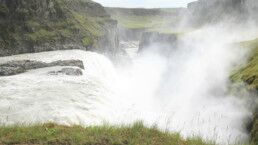
He did, however, allow for the land to be leased, opening a chapter in Icelandic history that has become close to mythos in the years since.
When plans to build the hydropower plant looked to be moving swiftly ahead, Tómas’ daughter, Sigriður, embroiled the buyers in a lengthy legal dispute, walking mile upon mile to court each day, and even going so far as to threaten to throw herself into Gullfoss’ raging waters should construction on the project begin.
Thankfully, the British defaulted on their payments, leaving Sigriður a hero to her people.
The rest, as they say, is history. Today, guests are free to enjoy Gullfoss as nature intended; a rare, soul-stirring feature destined to top bucket-lists for years to come. And before we forget, if you’re planning on seeing Gullfoss while discovering the Golden Circle in Iceland, make sure to bring your camera! You won’t want to forget this!
Gullfoss Waterfall

Gullfoss (“Golden Falls”) is a dramatic two-tier waterfall on the Hvítá river, located amidst the otherwise quaint agricultural surroundings of southwest Iceland. On approach, guests will likely spot an enormous plume of steam rising over the surrounding hilltops. So too will they hear the thunderous roar of rushing water. Then it appears, a true titan of the landscape.
Falling a total of 32 metres, Gullfoss cascades over two rocky steps, its frothing waters feeding the hungry mouth of Gullfossgjúfur canyon below. On either side of the river, the cliff sides rise to seventy metres, perfectly framing the waterfall for photographers looking upon it from either one of the site’s two viewpoints.
Pushing 140 cubic metres (459 cubic feet) of water every second of the summer, Gullfoss is a sight to behold. In the early 20th-century, there were plans to harness Gullfoss’ energy by building a Hydropower plant on site. Tómas Tómasson, who owned a farmstead at Gullfoss, refused to sign away ownership, famously telling the British businessmen in question, “I will not sell my friend!”

He did, however, allow for the land to be leased, opening a chapter in Icelandic history that has become close to mythos in the years since.
When plans to build the hydropower plant looked to be moving swiftly ahead, Tómas’ daughter, Sigriður, embroiled the buyers in a lengthy legal dispute, walking mile upon mile to court each day, and even going so far as to threaten to throw herself into Gullfoss’ raging waters should construction on the project begin.
Thankfully, the British defaulted on their payments, leaving Sigriður a hero to her people.
The rest, as they say, is history. Today, guests are free to enjoy Gullfoss as nature intended; a rare, soul-stirring feature destined to top bucket-lists for years to come. And before we forget, if you’re planning on seeing Gullfoss while discovering the Golden Circle in Iceland, make sure to bring your camera! You won’t want to forget this!
Hidden Gems near the Golden Circle in Iceland

As mentioned previously, there are several extras, hidden attractions that can be visited on the Golden Circle in Iceland for those who make the time. For one thing, guests can access several small towns and villages during their travels in the area.
Secret Lagoon in Flúðir Village
Flúðir is a picturesque settlement famed for the pillars of steam that billow at street-level, a sure sign of the geothermal underbelly on which the town rests.
With a population of little over 800 people, Flúðir is a great spot to grab some lunch between Geysir hot springs and Gullfoss waterfall.
The village’s hot springs are put to use at the Secret Lagoon, which has put Flúðir on the map since 1891. As one of the country’s oldest social hubs, there is a real air of authenticity bathing here, matched only by the intrigue and awe one feels looking at the live hot springs surrounding the pool itself.
If you book a Golden Circle Bubble trip with us, you’ll be sure to spend some quality time soaking in the luxurious waters of this popular stop.
Laugarvatn Fontana Spa

Those looking for an alternative spa to the Secret Lagoon should stop by Laugarvatn Fontana, which can be found central to the Golden Circle in Iceland. Complete with steam rooms, outdoor mineral baths, hot tubs and a Finnish-style sauna, Laugarvatn Fontana should be seen as the perfect rest stop for sightseers in the area.
Aside from allowing visitors to use their soothing facilities, the staff will also demonstrate how bread was baked in Iceland using geothermal energy. Starting from an old Icelandic recipe, Fontana’s bakery will dig their loaf into the warm ground, only to dig it up baked a full day later, finally serving it with a smidge of butter and a warm brew.
Mika Restaurant in Reykholt
Reykholt is another perfect village for taking a welcome lunch or dinner break while partaking in the Golden Circle in Iceland. The acclaimed restaurant Mika should be your number-stop if you’re feeling peckish for two reasons. First, their menu is superb, and second, they offer a range of homemade confectionery. What more could a hungry traveller ask for?
Renowned for its fresh and organic dishes, anyone taking part in our Golden Circle Bubble tour will get to sample Mika’s wide selection of delicious meals for themselves. Might we personally recommend the roasted lobster, served with garlic butter, or perhaps their lamb-stuffed pierogi pasta pillows?
Friðheimar tomato farm
A visit to Friðheimar is not so much a lunch stop as it is a fantastic all-round experience, perfect for families looking to add value to their time on the Golden Circle in Iceland.
Specialising in four tomato varieties, guests will eat directly inside the greenhouses, right beside where the fruit grows on the vine. Experts in horticulture, the green fingers behind Friðheimar grow tomatoes year-round, using artificial lighting to combat Iceland’s dark winters days.
After tucking into a lip-smacking course of mussels doused in tomato and basil sauce, or perhaps, a homemade Icelandic burrata, you can spectate the epic horse show that’s been entertaining guests since 2013.
Kerið volcanic crater
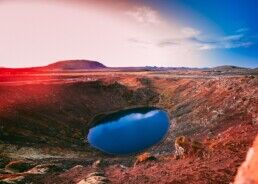
The Golden Circle in Iceland has many detours, the most famous of which, arguably, is Kerið volcanic crater. At around 3000 years old, Kerið is considered much younger than other volcanic features found in the Grímsnes area.
With its sloping scarlet walls, glistening basin pool and circular walking trail around the lip of the caldera, this stunning remnant of prior eruptions is a sight to behold.
An entrance fee of 400 ISK has been imposed to see this attraction, making it something of an anomaly in Iceland.
Hidden Waterfalls
You can see other natural sites during your time on the Golden Circle in Iceland, including Brúarfoss (‘Bridge Falls’) and Faxi waterfalls, both magnificent in their own right. While nowhere near as powerful as Gullfoss, each waterfall boasts a unique, photogenic beauty that makes diverting from the well-trodden path all the more worth it.
Brúarfoss is named after the large rock archway that once crossed the water, since disappeared due to water erosion. While this feature is long lost to time, the water’s vibrancy here is what really draws the eye.
Toned in a gorgeous aquamarine blue, Brúarfoss is a delight for photographers looking to pull colour from the Icelandic landscape.
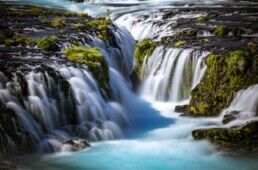
Faxi is around 12 kilometres from Geysir, 20 kilometres from Gullfoss, making it a quick and easy distraction during your day on the Golden Circle in Iceland. As part of the Tungufljót river, Faxi is at once recognisable thanks to its 80-metre width, far more significant than its relatively meagre height of 7-metres.
Though something of a mystery, Faxi waterfall is also known as Vatnsleysufoss, which roughly translates to “No Water Falls”. It’s hard to understand how such a name could come about given the power and beauty on display.
Langjökull Glacier
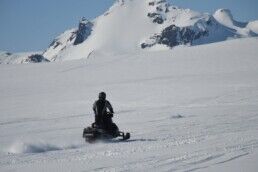
Adventurers looking for a real thrill-ride might opt for a spot of snowmobiling on the mighty glacier Langjökull (“Long Glacier”). As you might expect, snowmobiling is a popular activity for day-trippers in the southwest, offering breath-taking views, bare-knuckle speeds and a visit to one of the country’s most beautiful ice caps.
Langjökull is Iceland’s second biggest ice cap after Vatnajökull, at the opposite end of the country. With a volume of 195 km³, Langjökull’s ice can reach up to 580 metres in thickness. Its water feeds into numerous rivers in the country, and even that found in Silfra Fissure can trace its origins back to the glacier.
Hidden Gems near the Golden Circle in Iceland

As mentioned previously, there are several extras, hidden attractions that can be visited on the Golden Circle in Iceland for those who make the time. For one thing, guests can access several small towns and villages during their travels in the area.
Secret Lagoon in Flúðir Village
Flúðir is a picturesque settlement famed for the pillars of steam that billow at street-level, a sure sign of the geothermal underbelly on which the town rests.
With a population of little over 800 people, Flúðir is a great spot to grab some lunch between Geysir hot springs and Gullfoss waterfall.
The village’s hot springs are put to use at the Secret Lagoon, which has put Flúðir on the map since 1891. As one of the country’s oldest social hubs, there is a real air of authenticity bathing here, matched only by the intrigue and awe one feels looking at the live hot springs surrounding the pool itself.
If you book a Golden Circle Bubble trip with us, you’ll be sure to spend some quality time soaking in the luxurious waters of this popular stop.
Laugarvatn Fontana Spa

Those looking for an alternative spa to the Secret Lagoon should stop by Laugarvatn Fontana, which can be found central to the Golden Circle in Iceland. Complete with steam rooms, outdoor mineral baths, hot tubs and a Finnish-style sauna, Laugarvatn Fontana should be seen as the perfect rest stop for sightseers in the area.
Aside from allowing visitors to use their soothing facilities, the staff will also demonstrate how bread was baked in Iceland using geothermal energy. Starting from an old Icelandic recipe, Fontana’s bakery will dig their loaf into the warm ground, only to dig it up baked a full day later, finally serving it with a smidge of butter and a warm brew.
Mika Restaurant in Reykholt
Reykholt is another perfect village for taking a welcome lunch or dinner break while partaking in the Golden Circle in Iceland. The acclaimed restaurant Mika should be your number-stop if you’re feeling peckish for two reasons. First, their menu is superb, and second, they offer a range of homemade confectionery. What more could a hungry traveller ask for?
Renowned for its fresh and organic dishes, anyone taking part in our Golden Circle Bubble tour will get to sample Mika’s wide selection of delicious meals for themselves. Might we personally recommend the roasted lobster, served with garlic butter, or perhaps their lamb-stuffed pierogi pasta pillows?
Friðheimar tomato farm
A visit to Friðheimar is not so much a lunch stop as it is a fantastic all-round experience, perfect for families looking to add value to their time on the Golden Circle in Iceland.
Specialising in four tomato varieties, guests will eat directly inside the greenhouses, right beside where the fruit grows on the vine. Experts in horticulture, the green fingers behind Friðheimar grow tomatoes year-round, using artificial lighting to combat Iceland’s dark winters days.
After tucking into a lip-smacking course of mussels doused in tomato and basil sauce, or perhaps, a homemade Icelandic burrata, you can spectate the epic horse show that’s been entertaining guests since 2013.
Kerið volcanic crater

The Golden Circle in Iceland has many detours, the most famous of which, arguably, is Kerið volcanic crater. At around 3000 years old, Kerið is considered much younger than other volcanic features found in the Grímsnes area.
With its sloping scarlet walls, glistening basin pool and circular walking trail around the lip of the caldera, this stunning remnant of prior eruptions is a sight to behold.
An entrance fee of 400 ISK has been imposed to see this attraction, making it something of an anomaly in Iceland.
Hidden Waterfalls
You can see other natural sites during your time on the Golden Circle in Iceland, including Brúarfoss (‘Bridge Falls’) and Faxi waterfalls, both magnificent in their own right. While nowhere near as powerful as Gullfoss, each waterfall boasts a unique, photogenic beauty that makes diverting from the well-trodden path all the more worth it.
Brúarfoss is named after the large rock archway that once crossed the water, since disappeared due to water erosion. While this feature is long lost to time, the water’s vibrancy here is what really draws the eye.
Toned in a gorgeous aquamarine blue, Brúarfoss is a delight for photographers looking to pull colour from the Icelandic landscape.

Faxi is around 12 kilometres from Geysir, 20 kilometres from Gullfoss, making it a quick and easy distraction during your day on the Golden Circle in Iceland. As part of the Tungufljót river, Faxi is at once recognisable thanks to its 80-metre width, far more significant than its relatively meagre height of 7-metres.
Though something of a mystery, Faxi waterfall is also known as Vatnsleysufoss, which roughly translates to “No Water Falls”. It’s hard to understand how such a name could come about given the power and beauty on display.
Langjökull Glacier

Adventurers looking for a real thrill-ride might opt for a spot of snowmobiling on the mighty glacier Langjökull (“Long Glacier”). As you might expect, snowmobiling is a popular activity for day-trippers in the southwest, offering breath-taking views, bare-knuckle speeds and a visit to one of the country’s most beautiful ice caps.
Langjökull is Iceland’s second biggest ice cap after Vatnajökull, at the opposite end of the country. With a volume of 195 km³, Langjökull’s ice can reach up to 580 metres in thickness. Its water feeds into numerous rivers in the country, and even that found in Silfra Fissure can trace its origins back to the glacier.
4 Comments
Comments are closed.
[…] is necessary to pay a visit. The most famous example of this is Kerið volcanic crater on the Golden Circle sightseeing route, which has an entrance fee stipulated by the […]
[…] is found on the Golden Circle sightseeing route, a mere five-minute detour off the main trail. It is considered a side-attraction rather than a […]
[…] Brúarfoss waterfall sets itself apart thanks to its fantastical aesthetic and lack of crowds. This beautiful feature is one of the many side-attractions found on Iceland’s famous Golden Circle sightseeing route. […]
[…] has long been a favourite spot among visitors travelling the Golden Circle sightseeing route. Drawing the eye with its vibrant colour and almost perfect form, Kerid has better maintained its […]